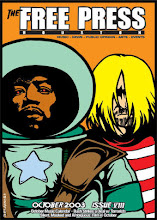Mister Lonely
 There's a similarity in review proof films, movies that inhabit opposite sides of the cinematic divide. On one hand you have tent pole studio summer releases with advertising budgets in excess of $50-million. Nothing anybody writes or says will really affect the opening. On another planet you have small independently produced films whose directors encourage devotion through a singular inaccessible vision. Case in point Mister Lonely. I've had fans of Harmony Korine asking me about his latest film for months so that has to account to some degree on a lingering sense of anticipation to see the film.
There's a similarity in review proof films, movies that inhabit opposite sides of the cinematic divide. On one hand you have tent pole studio summer releases with advertising budgets in excess of $50-million. Nothing anybody writes or says will really affect the opening. On another planet you have small independently produced films whose directors encourage devotion through a singular inaccessible vision. Case in point Mister Lonely. I've had fans of Harmony Korine asking me about his latest film for months so that has to account to some degree on a lingering sense of anticipation to see the film.The first images of Mister Lonely had me convinced it was the second coming. The opening moment is a slow motion long take telephoto shot that follows a Michael Jackson impersonator on a mini-cycle towing a kite of a monkey while the titular song warbles. This one-take credit sequence cuts to a nun, in a pleasant light blue habit, holding a spider monkey. Mister Lonely had me enthralled, and then the drugs wore off.
In addition to Diego Luna as Jackson the film's characters imitate famous celebs like Marilyn Monroe (Samantha Morton), Charlie Chaplin, Sammy Davis, Jr. as well as fictional characters like all Three Stooges, Little Red Riding Hood and Buckwheat. This is basically stunt casting, for instance the Queen and the Pope are played by Anita Pallenberg and James Fox. For film insiders roles are played by Leos Carax and Werner Herzog.
Mister Lonely goes off the rails before too much time has elapsed. Indie filmmakers like Jim Jarmusch or Gregg Araki can mix hip images and absurd situations without delving into undecipherable montage. The other side of the coin dictates a narrow, singular vision unhampered by mere logic. The celeb impersonators hang out at Charlie's house, one of them eventually commits suicide and the Stooges shoot a bunch of diseased sheep (at least one is black). A different narrative string has a group of nuns who fly. Rather than a magical moment where all these elements congeal for a tasty treat it seems that Korine has instead created a new millennium Six Characters in Search of a Auteur. Sadly Korine is no Pirandello.
There are thematic parallels to Korine's twin Mr. Lonely stories and they deal with life and death. When one of the nuns falls out of an airplane accidentally she prays to fly and not die. It's a miracle when she gets up off the ground without even dusting off and walks away unharmed. Korine seems especially eager to be transcendental. Soon the other nuns skydive without parachutes en masse with the express purpose of, well, flying. The cinematography and stunt work is amazing. In the back of my mind I found myself admiring how the stunt performers were hiding their parachutes in the nun clothing. Likewise the slo-mo fetishistic intensity of Marcel Zyskind's photography (he works a lot with Michael Winterbottom) brought a sense of purpose to what should've been a mess.
The word on Harmony Korine is that his films are shocking. Maybe the early ones, like Gummo, but the only thing shocking about Mister Lonely was how old Pallenberg looked.










